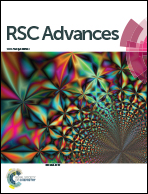Nitrogen-doped porous carbon obtained via one-step carbonizing biowaste soybean curd residue for supercapacitor applications
Abstract
In this work, we present a facile approach to prepare nitrogen-doped porous carbon materials via one-step carbonizing biowaste soybean curd residue (SCR) as the biomass carbon precursor. The morphology, structure and textural properties of the carbon materials are investigated by field emission scanning electron microscopy, transmission electron microscopy, N2 sorption isotherms, and X-ray photoelectron spectroscopy, respectively. The SCR carbonized at 700 °C exhibits a high charge storage capacity with a specific capacitance of 215 F g−1 at a current density of 0.5 A g−1 and good stability over 5000 cycles. Moreover, the assembled symmetric supercapacitor device possesses a energy density of 9.95 W h kg−1 at a power density of 236 W kg−1, which is higher than that of commercially available supercapacitors. The high supercapacitor performance of the porous carbon can be due to the high surface area and effective nitrogen-doping, indicating it has great potential for supercapacitors.


 Please wait while we load your content...
Please wait while we load your content...